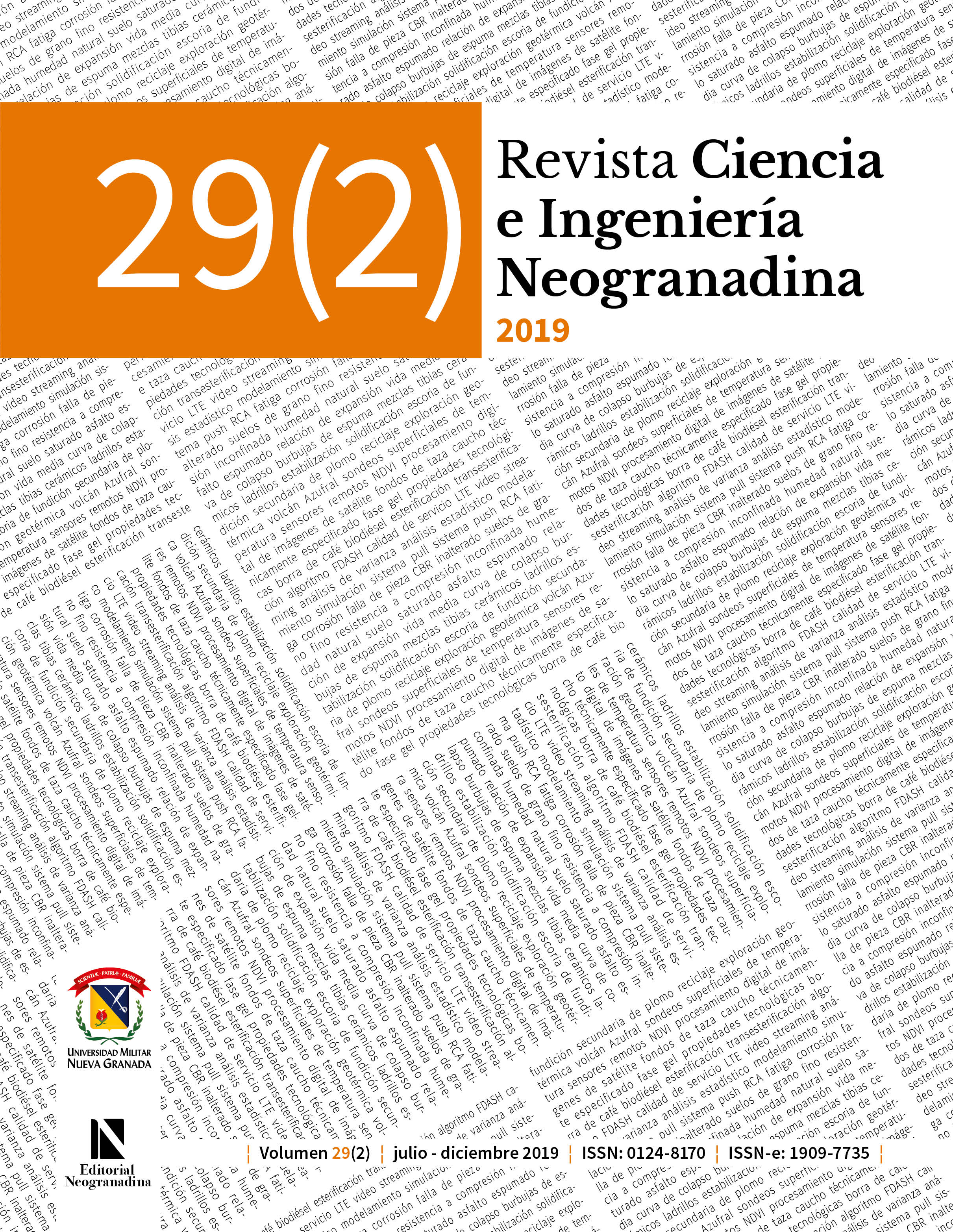Complementarity of energy resources for the electrical generation: a review
Abstract
Given the needs to increase the rates of electricity coverage, to generate measures to adapt the Climate Change and to diversify the Matrix Energy in the countries, there have been developed a lot of studies to establish the complementarity of energy resources. In that sense, this document presents a literature review of some regions worldwide, to highlight the research initiatives around the study of energy complementarity. This review includes studies about establishing the complementarity of solar, wind and water resources, and includes demand, electricity prices, etc. Among the results found, it is noted that although several studies conducted around the world have shown that most of the renewable energy production systems has a variable and unpredictable nature, make use of more than one type of renewable energy improves the performance of those systems, it decreases the generation fluctuations and increases the system reliability. Also, it is found that the correlation factor is the most used method for the evaluation of energy complementarity. Other methods include simulations, model application, optimization algorithms, etc. In the same way, the input information for the realization of these studies comes from the registries of the electrical power systems of the countries, from the application of meteorological prediction models, from historical climatological data coming from satellites or from measurements of meteorological stations, among others. There are opportunities observed in Colombia to generate knowledge about complementarity between energy resources.
Downloads
References
XM Expertos en Mercados, “Informe de Operación del SIN y Administración del Mercado - Generación del SIN,” 2017. [Online]. Available: http://informesanuales.xm.com.co/2015/SitePages/operacion/2-4-Generación-del-SIN.aspx. [Accessed: 15-Nov-2017].
Unidad de Planeación Minero Energética (UPME), “Estudio para determinar la vulnerabilidad y las opciones de adaptación del sector energético colombiano frente al cambio climático,” 2013.
Congreso de Colombia, “Ley N° 1715 del 13 de mayo de 2014,” Upme, no. May, p. 26, 2014.
FEDESARROLLO Centro de Investigación Económica y Social, “Análisis costo beneficio de energías renovables no convencionales en Colombia,” 2013.
Unidad de Planeación Minero Energética (UPME), “Plan Indicativo de Expansión de Cobertura de Energía Eléctrica (PIEC) 2016-2020,” pp. 0–48, 2016.
J. Serván, “Análisis técnico-económico de un sistema híbrido de baja potencia eólico solar conectado a la red,” 2014.
Banco Interamericano de Desarrollo, “Energías renovables variables y su contribución a la seguridad energética: complementariedad en Colombia,” 2017.
K. Engeland, M. Borga, J.-D. Creutin, B. François, M.-H. Ramos, and J.-P. Vidal, “Space-time variability of climate variables and intermittent renewable electricity production – A review,” Renew. Sustain. Energy Rev., vol. 79, no. February, pp. 600–617, 2017.
A. Beluco, P. K. de Souza, and A. Krenzinger, “A dimensionless index evaluating the time complementarity between solar and hydraulic energies,” Renew. Energy, vol. 33, no. 10, pp. 2157–2165, 2008.
C. de Oliveira Costa Souza Rosa, K. A. Costa, E. da Silva Christo, and P. B. Bertahone, “Complementarity of hydro, photovoltaic, and wind power in Rio de Janeiro State,” Sustain., vol. 9, no. 7, pp. 1–12, 2017.
F. Monforti, T. Huld, K. Bódis, L. Vitali, M. D’Isidoro, and R. Lacal-Arántegui, “Assessing complementarity of wind and solar resources for energy production in Italy. A Monte Carlo approach,” Renew. Energy, vol. 63, pp. 576–586, 2014.
L. Xu, X. Ruan, C. Mao, B. Zhang, and Y. Luo, “An Improved Optimal Sizing Method for Wind-Solar-Battery Hybrid Power System,” IEEE Trans. Sustain. Energy, vol. 4, no. 3, pp. 774–785, 2013.
A. Ademovic and M. Music, “Compatibility of Wind and Solar Power Generation in Reducing Effects of Power Output Intermittency – Case Study,” pp. 358–365, 2014.
G. A. Marrero and F. J. Ramos-Real, “Electricity generation cost in isolated system: The complementarities of natural gas and renewables in the Canary Islands,” Renew. Sustain. Energy Rev., 2010.
F. J. Santos-Alamillos, D. Pozo-Vázquez, J. A. Ruiz-Arias, V. Lara-Fanego, and J. Tovar-Pescador, “Analysis of spatiotemporal balancing between wind and solar energy resources in the southern Iberian Peninsula,” J. Appl. Meteorol. Climatol., vol. 51, no. 11, pp. 2005–2024, 2012.
E. Richard, T. Ortiz, and E. Fadigas, “Metodología de jerarquización de áreas para proyectos eólicos mediante análisis secuencial de correlación combinatoria hídrica-eólica,” 2011.
E. Kahn, “The reliability of distributed wind generators,” Electr. Power Syst. Res., vol. 2, no. 1, pp. 1–14, 1979.
L. Landberg, “The vailability and variability of the European wind resource,” Int. J. Sol. Energy, vol. 18, no. 4, pp. 313–320, 1997.
C. L. Archer and M. Z. Jacobson, “Spatial and temporal distributions of U.S. winds and wind power at 80 m derived from measurements,” J. Geophys. Res. Atmos., vol. 108, no. D9, p. n/a-n/a, 2003.
International Renewable Energy Agency (IRENA), “Renewable Energy Market Analysis: Latin America,” 2016.
N. José De Castro, G. De, A. D. André, L. Da, S. Leite, and J. Goodward, “Perspectivas para a Energia Eólica no Brasil,” 2010.
G. C. Palfi and R. C. Zambon, “Hydro and Wind Power Complementarity and Scenarization in Brazil,” World Environ. Water Resour. Congr. 2013, pp. 2414–2424, 2013.
P. S. Dos Anjos, A. S. Alves Da Silva, B. Stošić, and T. Stošić, “Long-term correlations and cross-correlations in wind speed and solar radiation temporal series from Fernando de Noronha Island, Brazil,” Phys. A Stat. Mech. its Appl., vol. 424, pp. 90–96, 2015.
V. S. Lopes and C. L. T. Borges, “Impact of the Combined Integration of Wind Generation and Small Hydropower Plants on the System Reliability,” IEEE Trans. Sustain. Energy, vol. 6, no. 3, pp. 1169–1177, 2015.
D. S. Ramos, L. A. S. Camargo, E. Guarnier, and L. T. Witzler, “Minimizing market risk by trading hydro-wind portfolio: A complementarity approach,” Int. Conf. Eur. Energy Mark. EEM, 2013.
Fundación Julio Ricaldoni Ingeniería en el Uruguay, “Complementariedad de las Energías Renovables en Uruguay y valorización de proyectos para el filtrado de su variabilidad,” pp. 1–108, 2014.
Fundación Julio Ricaldoni Ingeniería en el Uruguay et al., “Análisis de complementariedad de los recursos eólico y solar para su utilización en la generación eléctrica en gran escala en Uruguay,” 2016.
O. A. Jaramillo, M. A. Borja, and J. M. Huacuz, “Using hydropower to complement wind energy: A hybrid system to provide firm power,” Renew. Energy, vol. 29, no. 11, pp. 1887–1909, 2004.
K. Suomalainen, G. Pritchard, B. Sharp, Z. Yuan, and G. Zakeri, “Correlation analysis on wind and hydro resources with electricity demand and prices in New Zealand,” Appl. Energy, vol. 137, pp. 445–462, 2015.
S. Sinha and S. S. Chandel, “Prospects of solar photovoltaic-micro-wind based hybrid power systems in western Himalayan state of Himachal Pradesh in India,” Energy Convers. Manag., vol. 105, pp. 1340–1351, 2015.
I. Kougias, S. Szabó, F. Monforti-Ferrario, T. Huld, and K. Bódis, “A methodology for optimization of the complementarity between small-hydropower plants and solar PV systems,” Renew. Energy, vol. 87, pp. 1023–1030, 2016.
K. Vogstad, “Utilising the complementary characteristics of wind power and hydropower through coordinated hydro production scheduling using the EMPS model,” Wind Power 21st century, no. December, pp. 1–5, 2000.
A. A. Prasad, R. A. Taylor, and M. Kay, “Assessment of solar and wind resource synergy in Australia,” Appl. Energy, vol. 190, pp. 354–367, 2017.
W. Li, S. Stadler, and R. Ramakumar, “Modeling and Assessment of Wind and Insolation Resources with a Focus on Their Complementary Nature : A Case Study of Oklahoma Modeling and Assessment of Wind and Insolation Resources with a Focus on Their Complementary Nature : A Case Study of Oklahoma,” Ann. Assoc. Am. Geogr., vol. 101, no. September, pp. 37–41, 2010.
J. Widén, “Correlations between large-scale solar and wind power in a future scenario for Sweden,” IEEE Trans. Sustain. Energy, vol. 2, no. 2, pp. 177–184, 2011.
S. B. Kim et al., “Correlation Analysis of Renewable Energy Sources for Future Power Preparation in Jeju,” vol. 19, pp. 135–138, 2013.
D. Rimantas Pranas and S. Aldas, “Modelling and Analysis of Wind and Solar Generation,” pp. 139–142, 2014.
W. P. Bell, P. Wild, J. Foster, and M. Hewson, “Wind speed and electricity demand correlation analysis in the Australian National Electricity Market: Determining wind turbine generators’ ability to meet electricity demand without energy storage,” Econ. Anal. Policy, vol. 48, pp. 182–191, 2015.
B. François, M. Borga, J. D. Creutin, B. Hingray, D. Raynaud, and J. F. Sauterleute, “Complementarity between solar and hydro power: Sensitivity study to climate characteristics in Northern-Italy,” Renew. Energy, vol. 86, pp. 543–553, 2016.
M. Mowers, C. Helm, and N. Blair, “Correlations Between Geographically Dispersed Concentrating Solar Power And Demand In The United States,” pp. 1–9, 2017.
F. J. Santos-Alamillos, D. Pozo-Vázquez, J. A. Ruiz-Arias, L. Von Bremen, and J. Tovar-Pescador, “Combining wind farms with concentrating solar plants to provide stable renewable power,” Renew. Energy, vol. 76, pp. 539–550, 2015.
C. E. Hoicka and I. H. Rowlands, “Solar and wind resource complementarity: Advancing options for renewable electricity integration in Ontario, Canada,” Renew. Energy, vol. 36, no. 1, pp. 97–107, 2011.
M. Huber, D. Dimkova, and T. Hamacher, “Integration of wind and solar power in Europe: Assessment of flexibility requirements,” Energy, vol. 69, pp. 236–246, 2014.
A. Beluco, P. Kroeff de Souza, and A. Krenzinger, “A method to evaluate the effect of complementarity in time between hydro and solar energy on the performance of hybrid hydro PV generating plants,” Renew. Energy, vol. 45, pp. 24–30, 2012.
D. B. Richardson and L. D. D. Harvey, “Strategies for
correlating solar PV array production with electricity demand,” Renew. Energy, vol. 76, pp. 432–440, 2015.
A. J. Ealo Otero, “Análisis de generación complementaria entre energía hidráulica y eólica caso: generación ISAGEN - proyectos eólicos en la Guajira Colombiana,” p. 99, 2011.
C. A. González Manosalva, “Definición de la composición en las fuentes hidráulica y eólica para la generación de energía eléctrica en el contexto colombiano aplicando la teoría de portafolio,” 2012.
Banco Interamericano de Desarrollo, Unidad de Planeación Minero Energética (UPME), M. de M. y Energía, and COWI, “Impact analysis for integration of wind power generation in Colombia project report,” 2014.
W. Vergara et al., Wind energy in Colombia : a framework for market entry. World Bank, 2010.
Unidad de Planeación Minero Energética (UPME), “Formulación de un plan de desarrollo para las fuentes no convencionales de energía en Colombia (PDFNCE). Volumen 3 - Elementos de política, riesgos ante el cambio climático, complementariedad entre las FNCE y el SIN, y costos indicativos de las FNCE.,” 2010.
Unidad de Planeación Minero Energética (UPME), “Plan de Energización Sostenible del Departamento de Cundinamarca - Diagnóstico Energético,” no. 40, 2017.











